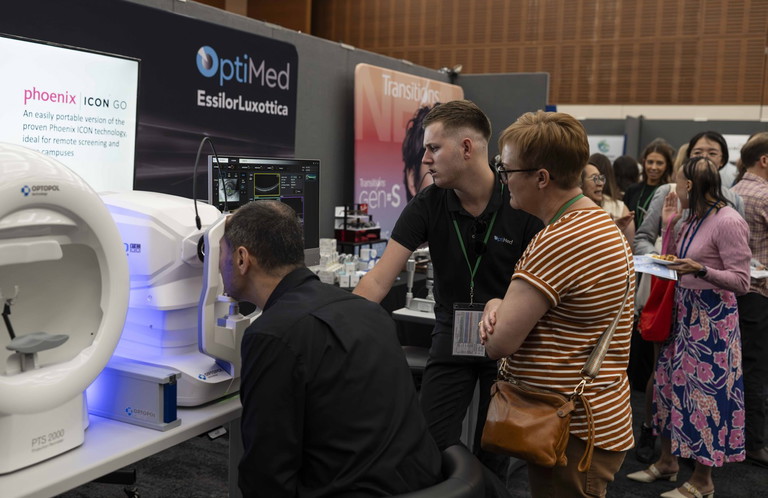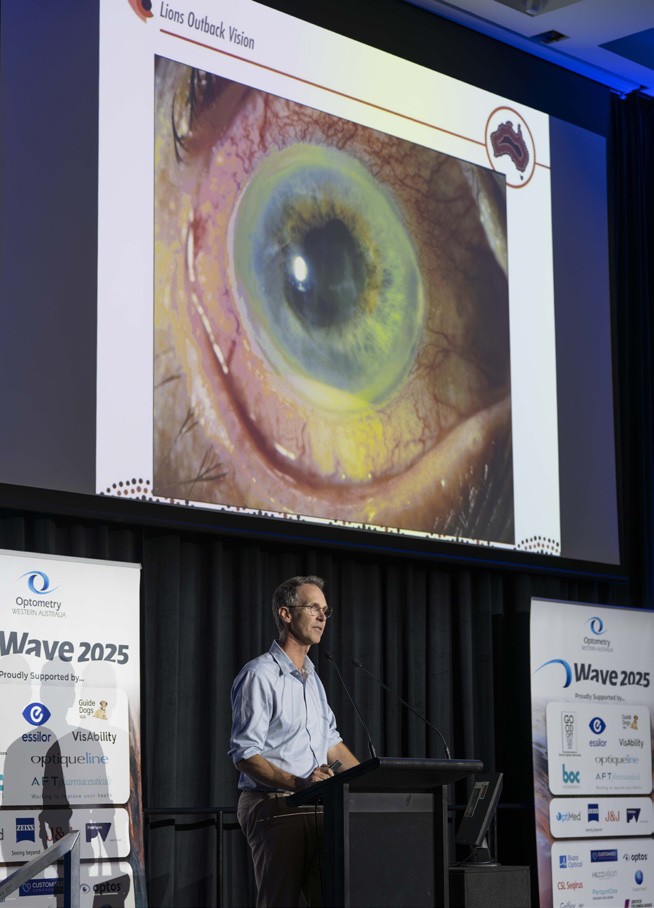mievent

OWA President, Stephanie Bahler.
Riding the Crest of WAVE 2025
WRITER Jingyi Chen
Timed to coincide with World Optometry Day, Optometry Western Australia (OWA) held its annual WAVE conference in Fremantle, Perth from 22–23 March 2025. As in previous years, WAVE was offered in a hybrid format, attracting a sold-out 225 inperson delegates and almost 400 online delegates over the weekend. Jingyi Chen from the University of Western Australia went along to cover the event for mivision.
Featuring a stellar line up of presenters and a wide array of topics, WAVE goes beyond an optometry educational programme. For the second year in a row, this engaging conference included a dispensing stream hosted by Optical Dispensers Australia (ODA), and for the first time, an inaugural e-poster competition and an extended invitation for optometry students to attend.
The conference attracted delegates from Perth, rural Western Australia, interstate, and internationally. “I loved the location of Fremantle. We spent time by the sea but also had the chance to explore Perth city, which is half an hour away,” said Connie Li, an optometrist from Rockhampton, Queensland. “We met some lovely WA optometrists and caught up with some colleagues from Queensland who also thought to make a holiday out of it.”
The annual sundowner saw opportunities for optometrists, dispensers, and industry to reconnect and to meet new faces. Pricilla Ho, local Perth optometrist and President of Early Career Optometrists WA said, “I always look forward to the sundowner, which is the perfect way to unwind with live music, networking and great conversations”.
THERAPEUTICS, GLAUCOMA, AND DRY EYE
Noongar Elder Mr Neville Collard began the conference with a Welcome to Country. Richard Johnson, the principal optometrist from Greenlane Hospital Ophthalmology Department in New Zealand, shared his experience managing patients in a collaborative clinic, including use of laser surgical procedures and virtual clinics for glaucoma and medical retina. Mr Johnson presented on ocular conditions with systemic associations commonly seen by community optometrists, including hypertensive retinopathy, arcus senilis, papilloedema, and giant cell arteritis, as well as prescribing of medicines. Optometrists in New Zealand have been able to prescribe medication for ocular conditions, including oral and intravitreal, since 2014. While optometrists in Australia are currently permitted to prescribe topical medications, the Trans-Tasman Mutual Recognition Act means that Australian optometrists must know how to safely prescribe and monitor usage of oral medications. An independent study found that between 2014–2019, there were no reported adverse events or out-of-scope prescribing by optometrists in New Zealand.1 Regarding prescribing oral medications in Australia, Mr Johnson said, “it is being taught at universities, and it will eventually change in Australia. If you do incorporate this into your practice, this will absolutely change it”.
The recently published Optometry Australia Quality Use of Medicines Clinical Practice Guidelines outlines the prescribing considerations for topical and oral therapeutic agents.2
Glaucoma experts Dr Jack Phu, Honorary Lecturer at the University of NSW, and Dr Geoffrey Chan, ophthalmologist and Clinical Lecturer at the University of Western Australia (UWA), presented on mimickers of glaucoma and the latest evidence on visual field interpretation. Dr Phu discussed visual field protocols, reliability indices, and shared clinical pearls on visual field interpretation. An example to differentiate glaucomatous field loss from mimickers was correlating the greyscale map with raw sensitivity values. A very sharp gradient at the border of a field defect is suggestive of a potentially retinal or vascular origin, compared with the gradual gradient that tends to occur in glaucoma.
The first day concluded with an anterior eye session presented by Martin Robinson, National President of Cornea and Contact Lens Society of Australia, and Luke Arundel, Chief Clinical Officer at Optometry Australia, covering dry eye and contact lens fitting.
DISPENSING STREAM
The dispensing stream drew strong interest with a half-day workshop on Saturday. In collaboration with WAVE, ODA brought together eye health professionals and fostered learning and networking opportunities. Introduced by ODA CEO April Petrusma, Paul Clarke OAM led a workshop in which delegates learnt specialised practical frame repair skills. Mr Clarke, the ODA Chair and Associate Lecturer (dispensing instructor) at UWA, explained that these skills allow dispensers to go above and beyond for their patients, ensuring high levels of customer satisfaction, confidence, and loyalty. For Dominique Jorgensen, Optical Dispensing Instructor and Technical Officer at UWA and an ODA qualified member, this hands-on workshop was a highlight. “We installed nose pads to an acetate frame and used heated tongs to remove and replace embedded hinges. Getting to learn and try out uncommon but highly useful skills was so exciting… the workshop was scheduled to be 2.5 hours with a 30-minute break, however most delegates were so engrossed in the activities that they continued right through the break!”
DIABETES
Diabetes is the fastest growing chronic disease in Australia, with 1.3 million known and registered people living with diabetes. It is the leading cause of preventable blindness in working age Australians.3 Community optometrists not only play an important role in monitoring diabetic retinopathy (DR) but may detect retinopathy in patients who are unaware they have diabetes. The diabetic session featured an impressive line-up of multidisciplinary experts on diabetes, including general practitioner (GP) Associate Professor Ramya Raman, consultant endocrinologist Dr Greg Ong, pharmacist and credentialled diabetes educator Jessica Weiss, and ophthalmologist Professor Angus Turner, all hailing from WA. Assoc Prof Raman, Specialist General Practitioner, Chair of the Royal Australian College of General Practitioners (RACGP) WA Faculty and RACGP Board Director, offered a general practitioner perspective on diabetic care, speaking about how community practitioners need to work as a team to reduce the burden of disease for best patient outcomes. She spoke about the need to “transition from episodic care to continual multidisciplinary care”. Dr Ong spoke about the types of diabetes beyond Type 1 and Type 2 diabetes mellitus, and Ms Weiss provided insight into medical management options for diabetes.
Prof Turner, Director of Lions Outback Vision, shared updates about digital health, including artificial intelligence (AI) assisted DR screening and telehealth. Prof Turner is an advocate for improving access to care through innovative collaborative care models and care integration. Lions Outback Vision services rural and remote areas of WA through the mobile eye clinic Vision Van, visiting optometry and ophthalmology outreach services, and the Kimberley Hub in Broome. It is the recent winner of the Pilbara Challenge, which aims to incorporate AI-outreach screening with multidisciplinary specialist management. While historical GP-DR screening implementation efforts have had low uptake in practice, AI-assisted DR screening appears promising with high diagnostic accuracy, speed, and ease of use. Prof Turner also discussed collaborative telehealth systems used in rural and remote Western Australia, which include on-call telehealth for acute ocular conditions and scheduled telehealth to expedite surgical bookings for conditions, such as cataract and pterygium. Although traditionally used in regional and rural areas only, Medicare changes during the COVID-19 pandemic saw previous kilometre distance restrictions lifted, meaning there is no longer a requirement for an optometrist to be located a certain number of kilometres from an ophthalmologist to bill the Medicare telehealth codes. Due to the efficiencies of the telehealth system, Prof Turner suggested that telehealth has the potential to be used in metropolitan settings to reduce wait times and improve access to eye health services.
PAEDIATRICS AND MYOPIA
Several experts presented on the latest evidence on children’s vision and myopia. Hayley McDonald, Lecturer at Flinders University in South Australia, presented tips on testing children’s vision and recent evidence on virtual reality. Extended reality, which encompasses virtual reality, augmented reality, and mixed reality, is increasingly used for entertainment, education, and training.
“I always look forward to the sundowner, which is the perfect way to unwind with live music, networking, and great conversations”

Richard Johnson
Ms McDonald discussed the opportunities for virtual reality including treatment of amblyopia and binocular vision disorders, myopia management, training of advanced skills such as surgery, empathy experiences, and unique learning environments such as for children with disabilities. Dr Emily Woodman-Pieterse, senior lecturer at the Queensland University of Technology, and Elisse Higginbotham, UWA Lecturer and clinician, provided updates on evidencebased myopia management including spectacle lens, contact lens, atropine, and emerging light therapies. Dr WoodmanPieterse addressed the ongoing debate surrounding red light therapy, noting that questions remain about the sufficiency of safety data for its widespread use. She also spoke about early evidence on the use of blue and violet light for myopia control, where trials are currently underway.
Mr Arundel returned on the second day to speak about optometry updates in 2025, highlighting the importance of cybersecurity in light of the recent increasing number of scams targeting small businesses. He urged optometrists and practice staff to explore training modules on the Cyber Aid programme, an initiative of the Australian government. In the advocacy space, Mr Arundel called for delegates to join the Optometry Australia campaign to reinstate two-yearly examinations for Australians. He also provided an update and clarification regarding changes to optometry Medicare billing codes, which were released in March 2025.2
BUZZING TRADE SHOW
The exhibition hall was buzzing with excitement between lectures, with Greg Cummings, exhibitor from Johnson and Johnson describing the conference as “incredibly engaging”. Mr Cummings said he had been “very impressed with the level of interaction from delegates”. In-person delegates had the chance to visit 24 exhibitors and all delegates (online and in-person) had opportunities to engage with supplier CPD and virtual exhibitor content. With sessions on offer from Bausch and Lomb, Essilor, KeepSight, Johnson and Johnson, Rodenstock, and InMode, supplier CPD proved to be a popular option alongside the clinical lectures and workshops. Competitions, both inperson and online, offered a multitude of prizes.
Overall, President of OWA Stephanie Bahler, described WAVE 2025 as filled with “insightful content and genuine connections”. OWA CEO and WAVE MC Evan MacRae described WAVE 2025 as perhaps our best to date. “The engagement levels of our combined face to face and online audience were a pleasure to witness, as was the level of supplier interaction,” he said.
WAVE 2026 will aim to continue in a similar but expanded vein.
References
1. Turnbull PR, Craig J P. Oral medication prescribing by optometrists in New Zealand. Clinical and Experimental Optometry. 2021;104(3):425-427. doi: org/10.1111/cxo.13089. 2. Optometry Australia. Medicare changes implemented from 1 March 2025 (webpage) available at: optometry. org.au/medicare_private_billing/medicare-changesimplemented-from-1-march-2025 [accessed Mar 2025]. 3. Diabetes Australia, Diabetes in Australia (webpage) available at: diabetesaustralia.com.au/about-diabetes/diabetes-in-australia/ [accessed April 2025].
Jingyi Chen BVisSc MOptom is a lecturer at the School of Allied Health, University of Western Australia, where she is currently undertaking her Doctor of Philosophy in rural eye health, collaborative care, and telehealth. She previously practised optometry in Batemans Bay, NSW and was Chair of Early Career Optometrists NSW/ACT.

Optometry WA, CEO, Evan MacRae and Stephanie Bahler.


Elisse Higginbotham above and below, Professor Angus Turner.
